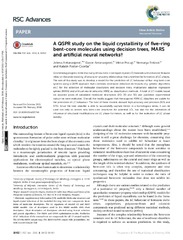A QSPR study on the liquid crystallinity of five-ring bent-core molecules using decision trees, MARS and artificial neural networks
2016
Аутори
Antanasijević, JelenaAntanasijević, Davor

Pocajt, Viktor

Trišović, Nemanja

Fodor-Csorba, Katalin
Чланак у часопису (Објављена верзија)
Метаподаци
Приказ свих података о документуАпстракт
Accelerating progress in the discovery of new bent-core liquid crystal (LC) materials with enhanced features relies on the understanding of structure-property relationships that underline the formation of LC phases. The aim of this study was to develop a model for the prediction of LC behaviour of five-ring bent-core systems using a QSPR approach that combines dimension reduction techniques (e.g. genetic algorithms etc.) for the selection of molecular descriptors and decision trees, multivariate adaptive regression splines (MARS) and artificial neural networks (ANN) as classification methods. A total of 27 models based on separate pools of calculated molecular descriptors (2D; 2D and 3D) and published experimental outcomes were evaluated. Overall, the results suggest that the acquired ANN LC classifiers are usable for the prediction of LC behaviour. The best of these models showed high accuracy and precision (91% and 97%). Since the best classifier is able to successfully capture trend...s in a homologous series, it can be used not only to screen new bent-core structures for potential LCs, but also for the estimation of influence of structural modifications on LC phase formation, as well as for the evaluation of LC phase stability.
Извор:
RSC Advances, 2016, 6, 22, 18452-18464Издавач:
- Royal Society of Chemistry
Финансирање / пројекти:
- Развој и примена метода и материјала за мониторинг нових загађујућих и токсичних органских материја и тешких метала (RS-MESTD-Basic Research (BR or ON)-172007)
- Проучавање синтезе, структуре и активности органских једињења природног и синтетског порекла (RS-MESTD-Basic Research (BR or ON)-172013)
DOI: 10.1039/c5ra20775d
ISSN: 2046-2069
WoS: 000370717900069
Scopus: 2-s2.0-84958955480
Институција/група
Tehnološko-metalurški fakultetTY - JOUR AU - Antanasijević, Jelena AU - Antanasijević, Davor AU - Pocajt, Viktor AU - Trišović, Nemanja AU - Fodor-Csorba, Katalin PY - 2016 UR - http://TechnoRep.tmf.bg.ac.rs/handle/123456789/3392 AB - Accelerating progress in the discovery of new bent-core liquid crystal (LC) materials with enhanced features relies on the understanding of structure-property relationships that underline the formation of LC phases. The aim of this study was to develop a model for the prediction of LC behaviour of five-ring bent-core systems using a QSPR approach that combines dimension reduction techniques (e.g. genetic algorithms etc.) for the selection of molecular descriptors and decision trees, multivariate adaptive regression splines (MARS) and artificial neural networks (ANN) as classification methods. A total of 27 models based on separate pools of calculated molecular descriptors (2D; 2D and 3D) and published experimental outcomes were evaluated. Overall, the results suggest that the acquired ANN LC classifiers are usable for the prediction of LC behaviour. The best of these models showed high accuracy and precision (91% and 97%). Since the best classifier is able to successfully capture trends in a homologous series, it can be used not only to screen new bent-core structures for potential LCs, but also for the estimation of influence of structural modifications on LC phase formation, as well as for the evaluation of LC phase stability. PB - Royal Society of Chemistry T2 - RSC Advances T1 - A QSPR study on the liquid crystallinity of five-ring bent-core molecules using decision trees, MARS and artificial neural networks EP - 18464 IS - 22 SP - 18452 VL - 6 DO - 10.1039/c5ra20775d ER -
@article{
author = "Antanasijević, Jelena and Antanasijević, Davor and Pocajt, Viktor and Trišović, Nemanja and Fodor-Csorba, Katalin",
year = "2016",
abstract = "Accelerating progress in the discovery of new bent-core liquid crystal (LC) materials with enhanced features relies on the understanding of structure-property relationships that underline the formation of LC phases. The aim of this study was to develop a model for the prediction of LC behaviour of five-ring bent-core systems using a QSPR approach that combines dimension reduction techniques (e.g. genetic algorithms etc.) for the selection of molecular descriptors and decision trees, multivariate adaptive regression splines (MARS) and artificial neural networks (ANN) as classification methods. A total of 27 models based on separate pools of calculated molecular descriptors (2D; 2D and 3D) and published experimental outcomes were evaluated. Overall, the results suggest that the acquired ANN LC classifiers are usable for the prediction of LC behaviour. The best of these models showed high accuracy and precision (91% and 97%). Since the best classifier is able to successfully capture trends in a homologous series, it can be used not only to screen new bent-core structures for potential LCs, but also for the estimation of influence of structural modifications on LC phase formation, as well as for the evaluation of LC phase stability.",
publisher = "Royal Society of Chemistry",
journal = "RSC Advances",
title = "A QSPR study on the liquid crystallinity of five-ring bent-core molecules using decision trees, MARS and artificial neural networks",
pages = "18464-18452",
number = "22",
volume = "6",
doi = "10.1039/c5ra20775d"
}
Antanasijević, J., Antanasijević, D., Pocajt, V., Trišović, N.,& Fodor-Csorba, K.. (2016). A QSPR study on the liquid crystallinity of five-ring bent-core molecules using decision trees, MARS and artificial neural networks. in RSC Advances Royal Society of Chemistry., 6(22), 18452-18464. https://doi.org/10.1039/c5ra20775d
Antanasijević J, Antanasijević D, Pocajt V, Trišović N, Fodor-Csorba K. A QSPR study on the liquid crystallinity of five-ring bent-core molecules using decision trees, MARS and artificial neural networks. in RSC Advances. 2016;6(22):18452-18464. doi:10.1039/c5ra20775d .
Antanasijević, Jelena, Antanasijević, Davor, Pocajt, Viktor, Trišović, Nemanja, Fodor-Csorba, Katalin, "A QSPR study on the liquid crystallinity of five-ring bent-core molecules using decision trees, MARS and artificial neural networks" in RSC Advances, 6, no. 22 (2016):18452-18464, https://doi.org/10.1039/c5ra20775d . .


